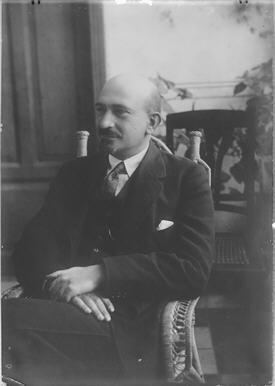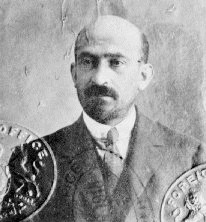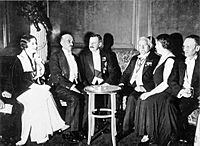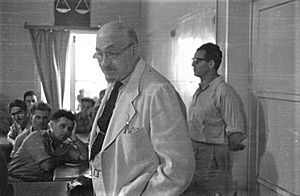Chaim Weizmann facts for kids
Quick facts for kids
Chaim Weizmann
|
|
|---|---|
|
חיים עזריאל ויצמן
|
|
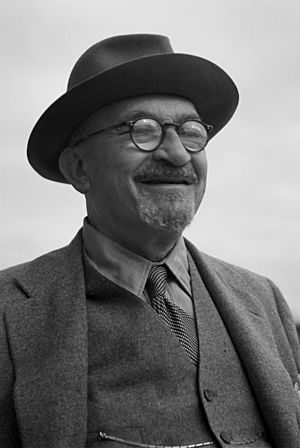
Weizmann in 1949
|
|
| 1st President of Israel | |
| In office 17 February 1949 – 9 November 1952 |
|
| Prime Minister | David Ben-Gurion |
| Preceded by | Himself (as Chairman of the Provisional State Council) |
| Succeeded by | Yitzhak Ben-Zvi |
| 2nd Chairman of the Provisional State Council of Israel | |
| In office 16 May 1948 – 17 February 1949 |
|
| Prime Minister | David Ben-Gurion |
| Preceded by | David Ben-Gurion |
| Succeeded by | Himself (as President) |
| Personal details | |
| Born |
Chaim Azriel Weizmann
27 November 1874 Motal, Russian Empire (now Belarus) |
| Died | 9 November 1952 (aged 77) Rehovot, Israel |
| Citizenship | Russian Empire United Kingdom Israel |
| Political party | General Zionists |
| Spouse | Vera Weizmann |
| Relations | Maria Weizmann (sister) Anna Weizmann (sister) Minna Weizmann (sister) Ezer Weizman (nephew) |
| Children | 2 |
| Alma mater | Technical University of Darmstadt Technical University of Berlin University of Fribourg |
| Profession | Biochemist |
| Known for | Politics: helped establish the State of Israel. Science: industrial fermentation, acetone–butanol–ethanol fermentation process, critical to the WWI Allied war effort. Founder of the Sieff Research Institute (now Weizmann Institute), helped establish the Hebrew University of Jerusalem. |
| Signature | |
Chaim Azriel Weizmann (Hebrew: חיים עזריאל ויצמן Chayyim Azri'el Vaytsman; 27 November 1874 – 9 November 1952) was an important scientist and a key leader in the movement to create the State of Israel. He was born in Russia and later became the first president of Israel. He was elected on 16 February 1949 and served until his death in 1952.
Weizmann played a huge part in getting the Balfour Declaration approved. This declaration was a statement from the British government that supported the idea of a Jewish homeland in Palestine. He also helped convince the United States to recognize the new State of Israel.
As a biochemist, Weizmann was a pioneer in using tiny living things (like bacteria) to make useful chemicals. This is called industrial fermentation. He developed a special process to make acetone, which was very important for making explosives during World War I. He also founded the Sieff Research Institute (now called the Weizmann Institute of Science) and helped start the Hebrew University of Jerusalem.
Contents
Biography
Chaim Weizmann was born in 1874 in a village called Motal, which is now in Belarus. At that time, it was part of the Russian Empire. He was one of 15 children. His father was a timber merchant.
From a young age, Chaim studied Hebrew and Jewish religious texts. When he was 11, he went to high school in Pinsk, where he showed a great talent for science, especially chemistry. He graduated with honors in 1892.
In 1892, Weizmann moved to Germany to study chemistry at the Polytechnic Institute in Darmstadt. To support himself, he taught Hebrew. In 1894, he moved to Berlin to continue his studies at the Technische Hochschule Berlin.
While in Berlin, he became involved with a group of people who supported Zionism. Zionism is the movement to create and support a Jewish homeland in Palestine. In 1897, he moved to Switzerland to finish his studies at the University of Fribourg. The next year, he attended the Second Zionist Congress in Basel.
Weizmann married Vera Khatzmann, and they had two sons. Their younger son, Michael Oser Weizmann, became a pilot in the Royal Air Force during World War II. Sadly, he was killed in 1942 when his plane was shot down.
Weizmann's nephew, Ezer Weizman, also became a very important figure in Israel. He was a commander in the Israeli Air Force and later served as President of Israel.
Chaim Weizmann is buried next to his wife in the garden of his home, which is on the grounds of the Weizmann Institute of Science. The institute was named after him.
Academic and Scientific Career
In 1899, Chaim Weizmann earned his PhD in organic chemistry. He then worked at the University of Geneva. In 1904, he moved to the United Kingdom to teach chemistry at the University of Manchester.
In 1910, he became a British citizen. He kept his British citizenship until 1948, when he gave it up to become the President of Israel. Weizmann and his family lived in Manchester for about 30 years. In Britain, he was known as Charles Weizmann and registered about 100 research patents.
Discovery of Synthetic Acetone
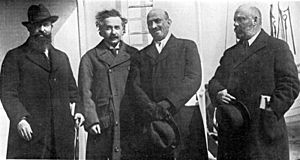
While teaching in Manchester, Weizmann became famous for finding a way to use bacteria to produce large amounts of useful chemicals. He is known as the "father of industrial fermentation." He used a special bacterium to create acetone.
Acetone was very important during World War I because it was used to make cordite, an explosive material needed for the British war effort. Weizmann gave the rights to his acetone production method to a company in exchange for payments.
When Winston Churchill learned about Weizmann's discovery, he and David Lloyd George (who was in charge of munitions) encouraged Weizmann to develop his process further. By 1916, industrial production of acetone began in six British factories. This effort produced a lot of acetone for the war. Because his work was so important, Weizmann gained favor with the British government. This allowed him to meet with important leaders and discuss the idea of a Jewish homeland.
Establishing Science Institutes
Weizmann also worked hard to create a science institute near his home in Rehovot, Israel. He believed that science could bring peace and success to the region. He famously said, "I trust and feel sure in my heart that science will bring to this land both peace and a renewal of its youth."
His efforts led to the creation of the Daniel Sieff Research Institute in 1934. This institute was later renamed the Weizmann Institute of Science in his honor. Weizmann himself did research there, focusing on organic chemistry.
During World War II, he advised the British government on things like synthetic rubber and high-quality gasoline.
Zionist Activism
Weizmann was a dedicated Zionist. He attended almost every Zionist Congress, which were meetings where leaders discussed the future of a Jewish homeland. From 1901, he pushed for a Jewish university in Palestine, an idea that later led to the founding of the Technion – Israel Institute of Technology in 1912 and the Hebrew University of Jerusalem.
Weizmann met Arthur Balfour, a former British Prime Minister, in 1905. Balfour supported the idea of a Jewish homeland. Weizmann is credited with helping to persuade Balfour to support the establishment of a Jewish homeland in Palestine. He famously told Balfour that Jews had lived in Jerusalem when London was still a marsh, showing the deep historical connection of the Jewish people to the land.
Weizmann believed that a Jewish state wouldn't just be given by governments. He said, "A state cannot be created by decree, but by the forces of a people and in the course of generations." He encouraged Jews to actively build up Palestine.
During World War I, Weizmann used his connections with British leaders to advance the Zionist cause. He formed friendships with important people like C. P. Scott, the editor of The Manchester Guardian. These connections helped him gain support for Zionism within the British government.
In 1917, after much discussion and debate, the British government issued the Balfour Declaration. This declaration stated that Britain supported the establishment of a national home for the Jewish people in Palestine. Weizmann considered this a huge success for the Zionist movement.
In 1919, Weizmann met with Prince Faisal, an Arab leader, to sign an agreement. This agreement aimed to establish good relations and recognize the rights of both Arabs and Jews in the region. Weizmann also spoke at the Paris Peace Conference, stating that the goal was to make Palestine as Jewish as England was English.
After 1920, Weizmann became the leader of the World Zionist Organization, serving as its president twice. He worked to encourage Jewish immigration to Palestine.
Jewish Immigration to Palestine

Jewish immigration to Palestine was sometimes limited by the British government. Weizmann was concerned about the rise of the Nazis in Europe and the need for Jews to have a safe place to go. From 1933, there was a big increase in Jewish immigration.
In 1936, Weizmann spoke before the Peel Commission, a group set up to look into the British rule of Palestine. He told them that there were 6 million Jews in Europe "for whom the world is divided into places where they cannot live and places where they cannot enter." The Commission suggested dividing Palestine into separate Jewish and Arab states. Weizmann and David Ben-Gurion supported this idea as a starting point for talks, but Arab leaders rejected it.
Weizmann believed that if more Jews had moved to Palestine earlier, a partition might not have been necessary.
Second World War and the Holocaust
When World War II began in 1939, Weizmann sent a letter to British Prime Minister Neville Chamberlain. He stated that Jews supported Great Britain and would fight alongside the democratic nations.
During the war, Weizmann advised the British government on supplies. He also worked to create the Jewish Brigade within the British Army, which fought against Germany.
Weizmann was deeply affected by the Holocaust, the terrible mass murder of Jews by the Nazis. He pushed for policies that would allow unlimited Jewish immigration to Palestine. He also urged the Allies to take action to help Jews trapped in Europe. He even suggested bombing the death camps, but this was deemed too risky.
Weizmann believed that Zionism was about creating a new life for the Jewish people, not just remembering past suffering.
First President of Israel
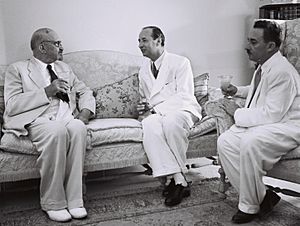
Just two days after the State of Israel was declared in 1948, Weizmann became the chairman of the Provisional State Council. This was like a temporary president.
In February 1949, when Israel held its first parliamentary election, Weizmann was elected as the first President of Israel. He worked to get support from other countries, including the United States, for the new state.
On 2 November 1949, the Daniel Sieff Institute, which Weizmann had helped create, was renamed the Weizmann Institute of Science. It became a very successful research center, attracting scientists from all over the world.
President Weizmann lived in Rehovot, where he often met with Prime Minister David Ben-Gurion. He passed away on 9 November 1952 and was buried in Rehovot. He is remembered as a great leader who helped create the State of Israel.
Published Works
- Weizmann, Chaim (1918). What is Zionism. London. https://archive.org/details/cu31924028583320.
- Weizmann, Chaim (1949). Trial and Error: The Autobiography of Chaim Weizmann. Jewish Publication Society of America.
- Weizmann, Chaim (1949). Autobiography: Chaim Weizmann. London: Hamilton Ltd.
- Weizmann, Chaim (Jan 1942). "Palestine's role in the solution of the Jewish Problem". Foreign Affairs 20 (2): 324–338. doi:10.2307/20029153.
- Herzog, Chaim (1996). Living History: a Memoir. Plunkett Lake Press. ASIN B013FPVJ42
Images for kids
See also
 In Spanish: Jaim Weizmann para niños
In Spanish: Jaim Weizmann para niños


